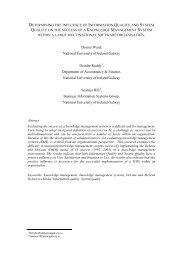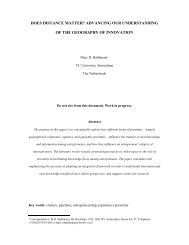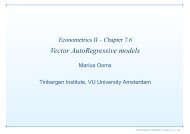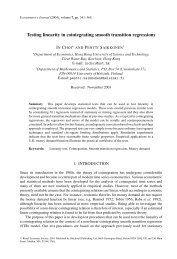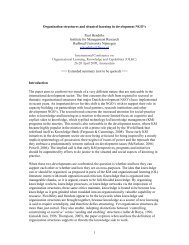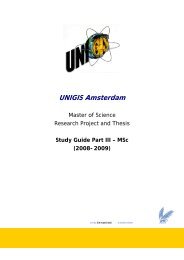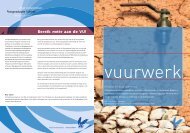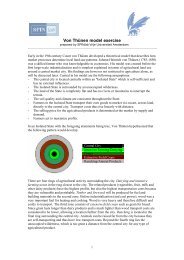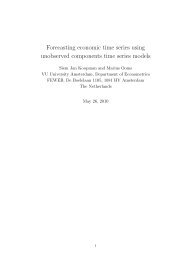The effects of road pricing - Feweb - Vrije Universiteit Amsterdam
The effects of road pricing - Feweb - Vrije Universiteit Amsterdam
The effects of road pricing - Feweb - Vrije Universiteit Amsterdam
You also want an ePaper? Increase the reach of your titles
YUMPU automatically turns print PDFs into web optimized ePapers that Google loves.
3.3.5 Vehicle occupancy<br />
Whereas congestion <strong>pricing</strong> and the derivation <strong>of</strong> optimal tolls have received ample attention,<br />
the issue <strong>of</strong> carpooling has largely been neglected in the literature. For instance, Daganzo<br />
(1982) made a first attempt to incorporate carpooling in equilibrium traffic assignment in<br />
general networks, but the demand for carpools is assumed to be fixed. This means that the<br />
model fails to include the mode choice behaviour <strong>of</strong> commuters. Yang and Huang (1999),<br />
however, use a deterministic equilibrium mode choice model with overall elastic demand.<br />
<strong>The</strong>ir analysis concerns the carpooling and congestion <strong>pricing</strong> problem in a multi-lane<br />
highway with HOV (high-occupancy vehicle) lanes. Numerical examples show the efficiency<br />
<strong>of</strong> HOV lanes, first- and second-best <strong>pricing</strong> and their combinations. Despite the fact that the<br />
model is highly simplified, the findings may be relevant for the design and operations <strong>of</strong><br />
combined congestion <strong>pricing</strong> and HOV lanes in practice, such as in California. <strong>The</strong>y found<br />
that marginal cost <strong>pricing</strong> provides the most efficient policy option under either elastic or<br />
inelastic demand. Reserving one or more entire lanes for carpooling vehicles rarely reduces<br />
total costs and nor does it improve social welfare, given marginal cost prices. Nevertheless,<br />
conventional carpool lanes alone can be justified at reasonably high congestion levels.<br />
Differentiation <strong>of</strong> tolls across commuting modes should be cautiously implemented. <strong>The</strong><br />
optimal uniform second-best toll is a weighted sum <strong>of</strong> the marginal external congestion costs<br />
between non-carpooling and carpooling commuters.<br />
3.3.6 Location choices<br />
<strong>The</strong> <strong>effects</strong> <strong>of</strong> <strong>road</strong> <strong>pricing</strong> on transport and location patterns have been much discussed.<br />
Simulation models for a typical city can be used to examine the impacts <strong>of</strong> <strong>road</strong> <strong>pricing</strong> on<br />
transport and location patterns. <strong>The</strong> model city should then be calibrated to replicate typical<br />
observed location and travel patterns. Model parameters, elasticities, functional forms, and so<br />
on can be taken from land use and transport models estimated on observed data. This should<br />
ensure that the conclusions are also applicable in reality. <strong>The</strong> first studies on this issue date<br />
back to the 1970s when Solow and Vickrey (1971) look at traffic patterns, congestion costs,<br />
and land use. <strong>The</strong>y show that, without congestion tolls, the market value <strong>of</strong> land may be a<br />
poor guide to land-use decisions, and lead to an overallocation <strong>of</strong> land to transportation.<br />
Solow (1973) confirms this result by using a simulation model <strong>of</strong> urban activity including the<br />
congestion costs <strong>of</strong> transportation. He shows that rents nearer the city are too low to properly<br />
reflect the social worth <strong>of</strong> transportation costs in the absence <strong>of</strong> congestion tolls. This will<br />
result in more land to be taken for use as <strong>road</strong>s than is socially desirable. It remains unknown<br />
what the consequences are for location patterns. Another topical contribution from this period<br />
compares a model <strong>of</strong> equilibrium land use patterns in the residential ring <strong>of</strong> an urban area with<br />
an optimal one (Oron et al., 1973). <strong>The</strong>y show that scarce resources can be saved by<br />
households moving from the periphery to more central locations in a distorted situation with<br />
suboptimal congestion tolls. Proper <strong>pricing</strong> <strong>of</strong> transportation will most probably lead to less<br />
suburbanisation.<br />
More recently, Eliasson and Mattsson (2001) have developed a simulation model <strong>of</strong> a generic<br />
city to study the <strong>effects</strong> <strong>of</strong> general congestion <strong>pricing</strong> and more specific toll ring <strong>pricing</strong>. <strong>The</strong><br />
city, consisting <strong>of</strong> homogenous zones, contains four types <strong>of</strong> actors: households, employers,<br />
shops, and service establishments. <strong>The</strong> location <strong>of</strong> households is determined by their value <strong>of</strong><br />
plot size and accessibility to workplace, shops and service establishments. Firms locate only<br />
according to accessibility to households. Shops and service establishments locate according to<br />
the accessibility to households with this difference – that they evaluate the expected number<br />
<strong>of</strong> customers in each zone. <strong>The</strong>y also take into account the proximity to working places and<br />
the size <strong>of</strong> the plot. It would go too far to discuss all other assumptions <strong>of</strong> the model at this<br />
point; rather we focus on the outcomes. It appears that the location <strong>effects</strong> <strong>of</strong> congestion<br />
38





